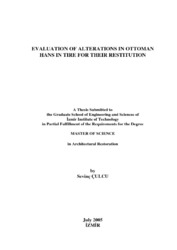Please use this identifier to cite or link to this item:
https://hdl.handle.net/11147/3298Full metadata record
| DC Field | Value | Language |
|---|---|---|
| dc.contributor.advisor | İpekoğlu, Başak | en |
| dc.contributor.author | Çulcu, Sevinç | - |
| dc.date.accessioned | 2014-07-22T13:51:15Z | - |
| dc.date.available | 2014-07-22T13:51:15Z | - |
| dc.date.issued | 2005 | en |
| dc.identifier.uri | http://hdl.handle.net/11147/3298 | - |
| dc.description | Thesis (Master)--Izmir Institute of Technology, Architectural Restoration, Izmir, 2005 | en |
| dc.description | Includes bibliographical references (leaves: 183-185) | en |
| dc.description | Text in English: Abstract: Turkish and English | en |
| dc.description | vi, 185 leaves | en |
| dc.description.abstract | In Turkish commercial buildings architecture, han buildings that were constructed between 13th and 19th century, are historical evidences that reveals commercial, social, cultural and economical condition of the cities in which they were located. These buildings were generally built in the regions that had commercial potential. As a result of increasing intensity, changes in economic structure etc. they lost their value and started to disappear rapidly. Tire, located in western Anatolia, a region of commercial and agricultural importance, was the center of Aydınoulları in Beylikler Period, and the center of Aydın Province in Ottoman Period. It was an important settlement in terms of politics, science, art and trade especially in the 15th and 16th centuries. In this period, as a result of increasing commercial activities, lots of hans were built. However, among these hans only Çöplüce Han, Kutu Han, Bakır Han, Ali Efe Han and Yeni Han exist today. Since they reflect one of the old Ottoman city.s physical status and also social, cultural and economical status of society, the conservation of these hans gains importance. At the planning period of the conservation study of Tire Hans, it is important to determine their original architectural characteristics. Therefore, the study focused on the investigation of alterations, and preparation of the restitution study which reveals their original state by the data obtained. Such enable one to take more conscious decisions for their preservations. First, the existing hans of Tire and their location were determined and their historical backgrounds were investigated. The present condition of these buildings and their alterations were determined and evaluated. The obtained data was supported with historical research and comparative studies. After that the restitution projects that show the original situation of these hans were prepared. Key Words: City Hans, Tire, Alteration, Restitution, Ottoman Hans | en |
| dc.language.iso | en | en_US |
| dc.publisher | Izmir Institute of Technology | en |
| dc.rights | info:eu-repo/semantics/openAccess | en_US |
| dc.subject | Ottoman Hans | en |
| dc.subject.lcc | NA7850.T9 .C96 2005 | en |
| dc.subject.lcsh | Caravansaries--Turkey--Conservation and restoration | en |
| dc.subject.lcsh | Architecture, Ottoman--Tire(Turkey) | en |
| dc.title | Evaluation of alterations in Ottoman hans in tire for their restitution | en_US |
| dc.type | Master Thesis | en_US |
| dc.institutionauthor | Çulcu, Sevinç | - |
| dc.department | Thesis (Master)--İzmir Institute of Technology, Conservation and Restoration of Cultural Heritage | en_US |
| dc.relation.publicationcategory | Tez | en_US |
| item.languageiso639-1 | en | - |
| item.fulltext | With Fulltext | - |
| item.openairecristype | http://purl.org/coar/resource_type/c_18cf | - |
| item.openairetype | Master Thesis | - |
| item.grantfulltext | open | - |
| item.cerifentitytype | Publications | - |
| Appears in Collections: | Master Degree / Yüksek Lisans Tezleri | |
Files in This Item:
| File | Description | Size | Format | |
|---|---|---|---|---|
| T000395.pdf | MasterThesis | 45.26 MB | Adobe PDF |  View/Open |
CORE Recommender
Page view(s)
156
checked on Jul 22, 2024
Download(s)
140
checked on Jul 22, 2024
Google ScholarTM
Check
Items in GCRIS Repository are protected by copyright, with all rights reserved, unless otherwise indicated.